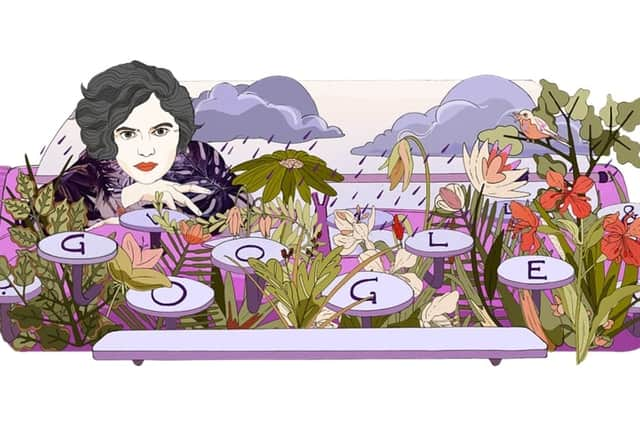Mascha Kaléko is being celebrated with a Google Doodle - here’s why


Today’s Google Doodle (Wednesday 16 September) celebrates Mascha Kaléko, a German-Jewish poet who rose to prominence during the mid 1930s.
Today’s date is significant because it marks the final in-person reading at Berlin’s America Memorial Library by Kaléko.
Advertisement
Hide AdAdvertisement
Hide AdThis is everything you need to know about her life and works.
Who is Mascha Kaléko?
Mascha Kaléko was actually born as Golda Malka Aufen, on 7 June 1907, in Schidlow, Galicia, which is an area we now know as southern Poland.
Prior to the outbreak of World War I, Kaléko’s family fled from Galicia to Germany. In 1918, her family settled in Berlin.
In 1938, Kaléko emigrated to the United States, where she lived in various areas, such as New York City and California. In 1959, she moved to Jerusalem, Israel.
What is she famous for?
Advertisement
Hide AdAdvertisement
Hide AdKaléko rose to fame as a poet, with her work garnering notable acclaim.
As a teenager, she began to write and within a few years, she had become a local celebrity in Berlin, due to newspapers in the city publishing her early work. By the early 1930s, Kaléko had become an established figure among Berlin’s literary greats.
According to Google, Kaléko “could often be found deep in conversation at the Romanische Cafe, the iconic bohemian hub frequented by notable contemporaries like Else Lasker-Schüler and Erich Kästner.”
In 1960, Kaléko was supposed to receive the Fontane Prize for Literature in Berlin, however she declined to accept the prize due to former Nazi and member of the Waffen-SS, Hans Egon Holthusen, being a member of the jury.
Which poems did she write?
Advertisement
Hide AdAdvertisement
Hide AdIn 1933, Kaléko published her first book of poetry called Lyrisches Stenogrammheft (The Lyrical Shorthand Pad).
Two years later, she published her second, titled Das kleine Lesebuch für Grosse (The Little Reader for Grown-ups).
Some of her poems were published posthumously, including Sozusagen grundlos vergnügt (Call it Causelessly Merry), in 1977, in a collection edited by Gisela Zoch-Westphal called In meinen Träumen läutet es Sturm (In my dreams, a storm is brewing).
Various attempts had been made to translate her individual poems into English, and in March 2010, a number of Kaléko’s poems appeared with full English translations in the book No Matter Where I Travel, I Come To Nowhereland - The Poetry of Mascha Kaléko, translated by Andreas Nolte.
Advertisement
Hide AdAdvertisement
Hide AdThe book contains a selected number of poems from every phase of her life, with translations that follow the original German texts as closely as possible, in order to preserve Kaléko’s style, rhythm and rhyme.
Was she married and did she have children?
In 1928, Kaléko married Saul Aaron Kalékom, who was a Hebrew teacher. However, the two later divorced.
Kaléko married her second husband in 1938, director and music theorist Chemjo Vinaver.
She had a son with Vinaver, Steven. Steven would go on to work in the arts, as a writer and theatre director. But, while directing a play in Massachusetts, Steven fell ill with pancreatitis, and passed away in 1968 at age 31.
When did she die?
Advertisement
Hide AdAdvertisement
Hide AdKaléko passed away on 21 January 1975 in Zurich. She had embarked on a final visit to Berlin and fell ill en route back to Jerusalem.
She is buried in Israelitischer Friedhof Oberer Friesenberg, a Jewish community organised as a unified parish in the Swiss city of Zurich. Provided by the community is the Synagoge Löwenstrasse in Zürich-City, a community centre and the largest Jewish library, and two cemeteries - Unterer and Oberer Friesenberg.
In Berlin, a street and park were named after her, with a memorial plaque placed at her former residence.
Who created today’s Google Doodle?
The Google Doodle celebrating Kaléko was illustrated by Hamburg-based guest artist, Ramona Ring.
Advertisement
Hide AdAdvertisement
Hide AdIn a Q&A with Google, Ring explained that she related to the topics Kaléko wrote about in her poems, and was “struck by the tender language she found for difficult feelings that come with being lost and without roots.”
Talking about when she was first approached about the project, the artist said, “I felt excited; I love reading poetry, especially by women. I was happy to dive into the often dark, sometimes bittersweet world Mascha created.
“Also I found it to be a delightful coincidence that Mascha [Kaléko] and I share the same birthday.”
Ring said that the inspiration for the floral design that the Doodle has comes from a metaphor used to describe fame in a poem written by Kaléko called Das Bißchen Ruhm - “flowers in a greenhouse that you have to keep watering and tending.”
Advertisement
Hide AdAdvertisement
Hide AdShe added, “I also liked how she talked about leaning against rain clouds in Die frühen Jahre: the clouds were a metaphor for the hardship she had to endure already as a young child.
“Those are the elements I drew from her poetry that inspired the Doodle artwork.”
Ring said that message she hoped to convey with the Google Doodle is that “it is possible to overcome very difficult circumstances and grow resilient in the face of despair.”
“I think expressing yourself through art is one of the most healing things you can engage in,” she added.
A version of this article originally appeared on our sister title The Scotsman